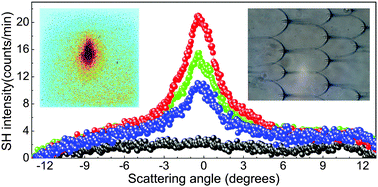Second harmonic light scattering induced by defects in the twist-bend nematic phase of liquid crystal dimers
Abstract
The nematic twist-bend (NTB) phase, exhibited by certain thermotropic liquid crystalline (LC) dimers, represents a new orientationally ordered mesophase – the first distinct nematic variant discovered in many years. The NTB phase is distinguished by a heliconical winding of the average molecular long axis (director) with a remarkably short (nanoscale) pitch and, in systems of achiral dimers, with an equal probability to form right- and left-handed domains. The NTB structure thus provides another fascinating example of spontaneous chiral symmetry breaking in nature. The order parameter driving the formation of the heliconical state has been theoretically conjectured to be a polarization field, deriving from the bent conformation of the dimers, that rotates helically with the same nanoscale pitch as the director field. It therefore presents a significant challenge for experimental detection. Here we report a second harmonic light scattering (SHLS) study on two achiral, NTB-forming LCs, which is sensitive to the polarization field due to micron-scale distortion of the helical structure associated with naturally-occurring textural defects. These defects are parabolic focal conics of smectic-like “pseudo-layers”, defined by planes of equivalent phase in a coarse-grained description of the NTB state. Our SHLS data are explained by a coarse-grained free energy density that combines a Landau-deGennes expansion of the polarization field, the elastic energy of a nematic, and a linear coupling between the two.



 Please wait while we load your content...
Please wait while we load your content...